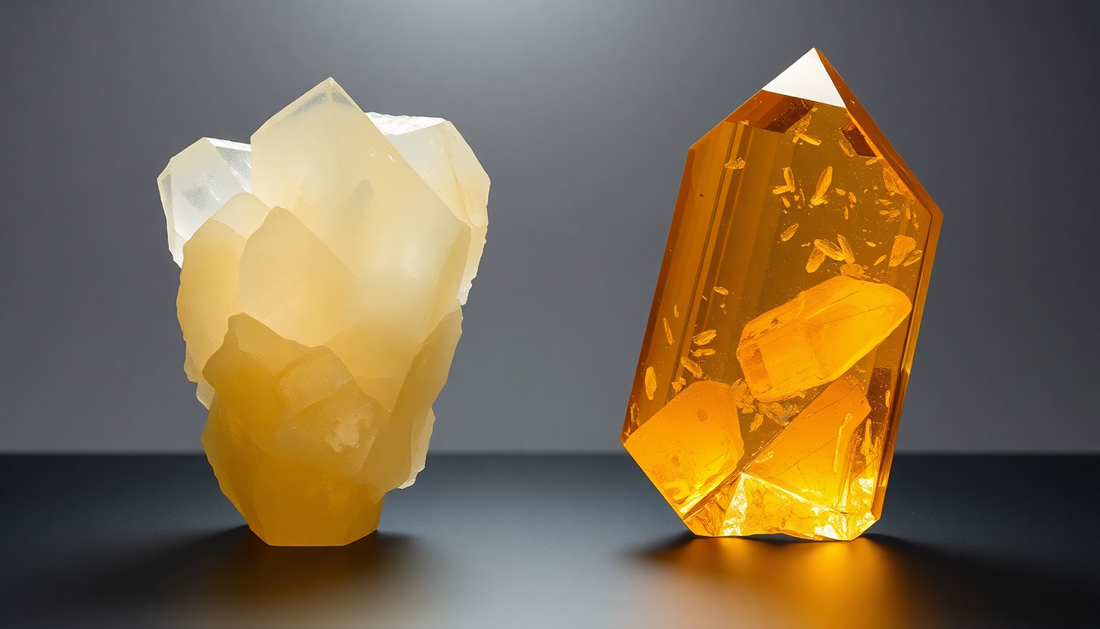
Unveiling the Differences: Yellow Quartz vs. Citrine
Share
In the captivating world of gemstones, two shades of yellow stand out - yellow quartz and citrine. These two gemstones, while sharing a similar hue, possess distinct origins, properties, and characteristics that set them apart. As a leading trader in natural gemstones, minerals, and jewelry, Natural Gems Belgium is excited to delve into the intriguing differences between these two captivating gems.
The Origins of Yellow Quartz and Citrine
Yellow quartz, often referred to as "lemon quartz," is a variety of the quartz mineral family. This vibrant gem is found in various locations around the world, including Brazil, Madagascar, and the United States. The yellow coloration in yellow quartz is typically the result of the presence of iron impurities within the crystal structure.
On the other hand, citrine is a distinct variety of quartz that is known for its warm, golden-yellow hue. Unlike yellow quartz, which is a natural occurrence, citrine is often the result of heat treatment applied to amethyst, another member of the quartz family. The heat treatment process causes the purple hues of amethyst to transform into the desired yellow tones of citrine.
Distinguishing Characteristics
While yellow quartz and citrine may appear similar at first glance, a closer examination reveals several distinguishing characteristics that set them apart.
Color Variations
One of the most notable differences between yellow quartz and citrine is the range of color variations. Yellow quartz can display a wide spectrum of yellow hues, ranging from pale lemon to deep, rich golden tones. Citrine, on the other hand, is typically more consistent in its coloration, showcasing a more uniform golden-yellow shade.
Clarity and Inclusions
Yellow quartz is often found with a higher degree of clarity compared to citrine. Due to the natural formation process, yellow quartz may contain fewer inclusions and impurities, resulting in a more transparent and visually appealing appearance. Citrine, on the other hand, may exhibit a slightly more cloudy or hazy appearance due to the heat treatment process.
Hardness and Durability
Both yellow quartz and citrine are members of the quartz family, which is known for its hardness and durability. However, yellow quartz is slightly harder on the Mohs scale, ranking at a 7 more ranging to 6, while citrine ranks at a 7 as well. This slight difference in hardness can impact the gemstones' resistance to scratches and wear over time.
Rarity and Pricing
When it comes to rarity and pricing, citrine generally holds an advantage over yellow quartz. Citrine is considered a more valuable and sought-after gemstone due to its unique formation process and the fact that it is less abundant in nature compared to yellow quartz. As a result, citrine typically commands a higher price point in the gemstone market.
Applications and Uses
Both yellow quartz and citrine have a wide range of applications and uses, making them popular choices among jewelry enthusiasts, collectors, and those seeking to harness the power of gemstones.
Jewelry and Accessories
Yellow quartz and citrine are commonly used in the creation of various jewelry pieces, such as rings, necklaces, earrings, and bracelets. Their vibrant hues and natural beauty make them a popular choice for both casual and formal attire. Additionally, these gemstones are often incorporated into accessories like pendants, charms, and beaded jewelry.
Decorative and Spiritual Purposes
Beyond their use in jewelry, yellow quartz and citrine are also valued for their decorative and spiritual properties. These gemstones are often used in home decor, such as in the form of bookends, paperweights, and decorative bowls. In the realm of spirituality, both yellow quartz and citrine are believed to possess healing and energizing properties, making them popular choices for meditation, crystal healing, and other spiritual practices.
Collector's Items
For gemstone enthusiasts and collectors, yellow quartz and citrine hold a special allure. Rare and unique specimens, such as large, well-formed crystals or intricately carved pieces, are highly sought after and can command premium prices in the collector's market.
Conclusion
In the captivating world of gemstones, the distinction between yellow quartz and citrine is a fascinating exploration. While these two gems may share a similar hue, their origins, characteristics, and applications set them apart, making each one a unique and valuable addition to any gemstone collection or jewelry ensemble.
As a leading trader in natural gemstones, minerals, and jewelry, Natural Gems Belgium is dedicated to providing our clients with the highest quality and most authentic gemstones, including both yellow quartz and citrine. Whether you're a seasoned collector, a jewelry enthusiast, or simply someone who appreciates the beauty and wonder of these captivating gems, we invite you to explore the world of yellow quartz and citrine with us.